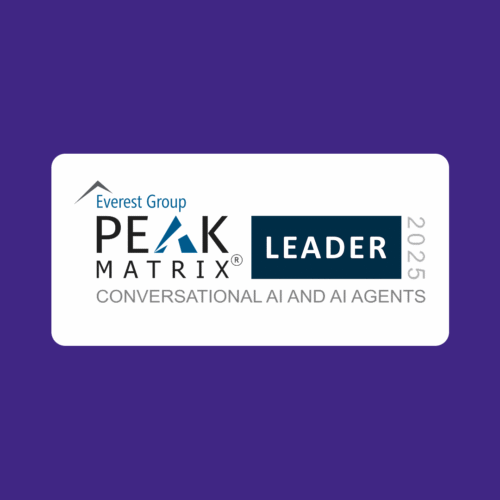Agentic AI is one of the most exciting developments in customer service technology. It’s dynamic, flexible, and capable of handling complex interactions. For enterprise leaders, the real question isn’t whether the tech works; it’s how to introduce it without losing control, breaching compliance, or putting customer trust at risk.
At Omilia, we’ve been deploying agentic AI miniApps® for years. Our Agentic approach is tuned on real world use cases, and allows for a mix of options that enable companies to deploy Agentic experiences that fully comply with their AI governance policies. We’ve seen what happens when companies rush in too quickly, or “buy the hype” of a new technology, rather than using the new technology optimally. So, if you’re exploring agentic AI for your contact center, here are five key questions to ask and missteps to avoid before diving in.
1. Are You Solving the Right Problem?
Agentic AI can be very good at engaging customers and managing context. Without a proven deployment model, Agentic AI can be inefficient in the resolution of a task. If you’ve ever asked an AI model to give you an opinion on “what is the best water heater I can buy?”, you may have been stunned at the level of didacticism that a simple question can create. Rather than getting a recommendation, you can be given the history of heating water going all the way back to the stone age–and an offered hypothesis on the relative economic impact of solar heating versus gas heating to future generations. This may completely overlook the fact that you may live in a climate where solar isn’t feasible.
Customers talk to humans because they just want simple answers. The longer the response, the less confident customers are in that response.
Successful Agentic deployments mix engagement and qualitative content generation (which Agentic is good at) with task completion and decision making (which traditional deterministic and probabilistic models are good at). When you have a high volume task (e.g., taking payments) where a few percentage points of success outcomes creates a dramatic improvement in outcomes, Agentic should complement a traditional deterministic AI model–”humanizing” caller prompts, handling edge cases (like out of domain utterances), and providing qualitative feedback. An example of an Agent model working inside a deterministic model is having an Agentic AI review a long ticket history, summarizing it for a structured ML model, and having the ML model give a response from a known list of responses that best matches the summary.
However, Agentic AI is also effective at breaking the “glass ceiling” of containment. Most customers find they have a handful of customer support inquiry (often 5 or less) that drive the majority (oftentimes 70% or more) of their interaction volume. In such instances, using Agentic inside Deterministic offers higher and higher limits.
Simultaneously, Agentic allows “good enough” customer service so that the 50+ kinds of customer inquiries that may represent 30% or less of your interaction volume can achieve at least a baseline level of service. In these cases, efficient automation can be achieved by allowing Agentic models to encounter customers fast (with almost no IT development time), to reinforce their learning continuously, and to take feedback from human administrators by policies, rules, and guidelines. This enables higher containment rates while learning from real human customers and agents.
Watch out for: Vendors who promise 95 percent containment out of the box. Agentic AI is powerful, but it works best when layered onto a proven deployment model complemented by the entire technology stack of models available.
2. Where is the risk – and who’s managing it?
Every organization has a different appetite for risk. Even within a single business, use cases vary. A bot that helps customers redeem loyalty points doesn’t carry the same risk as one that moves money or collects personal data. Remember: even within banking, “redeem my points” might be low risk, while “transfer $10,000+” demands zero tolerance for error.
Before rolling out agentic AI, map out your use cases. Start with areas where the potential upside is high and the risk is low. And make sure someone is responsible for overseeing risk – not just rolling out features.
3. What’s your supervision strategy?
One of the biggest myths around agentic AI is that success comes from removing humans entirely. In reality, the most effective agentic systems start with humans in the loop. The AI can plan, but people still validate, guide, or take action – especially early on.
Here’s how we support that at Omilia:
- Agentic planners that suggest actions, while human agents make the final call on what is executed
- Real-time escalations to humans providing visibility into the AI’s reasoning
- Gradual rollout paths that evolve from deterministic agents, to agent assist to autonomous execution
Think of it like training wheels for your AI….
- Agent Assist to gather data and build trust
- Supervised Planning, where AI suggests and humans decide
- Limited Autonomy in low-risk scenarios
You wouldn’t go from a tricycle to a motorcycle overnight, and your automation strategy shouldn’t either.
4. Can you see what the AI is doing?
Transparency is non-negotiable. If the AI is making decisions on your behalf, you need to know what it’s doing, why it’s doing it, and whether it’s doing it correctly – especially if you’re in a regulated industry.
Look for solutions that offer:
- Real-time observability into how plans are being made and executed
- Clear audit trails and policy controls
- Tools for collecting and acting on human feedback
If you can’t see inside your AI, you can’t trust it. And neither will your customers.
5. Do you have a phased deployment plan?
Agentic AI isn’t something you “flip on.” The best results come from a phased approach:
- Start with agent assist to build trust and gather data
- Introduce supervised planning, where AI makes suggestions but humans take action
- Gradually shift to autonomous execution for low-risk tasks
- Continuously tune and expand based on performance
This approach doesn’t slow innovation, it makes sure it sticks. It reduces risk and helps you get real, measurable results.
Bonus Callout: Compliance & Sovereignty Through In-House Model Tuning
Enterprises can’t afford to send sensitive call data to third-party APIs. Omilia’s roadmap to host and fine-tune its own planners ensures data never leaves the customer’s walls, giving regulated industries the compliance and sovereignty they demand, as well as lower latency and cost.
Final Takeaway: Let Strategy Lead, Not Hype
Agentic AI is ready, but that doesn’t mean your organization has to rush. Like autonomous vehicles, real adoption takes time. It happens in stages, with the right visibility, safeguards, and metrics to guide you.
At Omilia, we’re not just delivering the technology. We’re helping enterprises deploy it on their terms, in a way that builds trust every step of the way.
If you’re thinking about agentic AI, let’s talk about how to start small, move smart, and scale with confidence.
About the Author
Chris Adomaitis, Global Director, Solution Consulting
25 years selling contact center solutions, many of them with Voice and chat automation services. With deep expertise across CX, tech implementation, and international markets, he has held senior roles at Adapt and Serenova, and began his career at a global BPO where he rose to an executive role by aligning service tech with complex enterprise needs.


